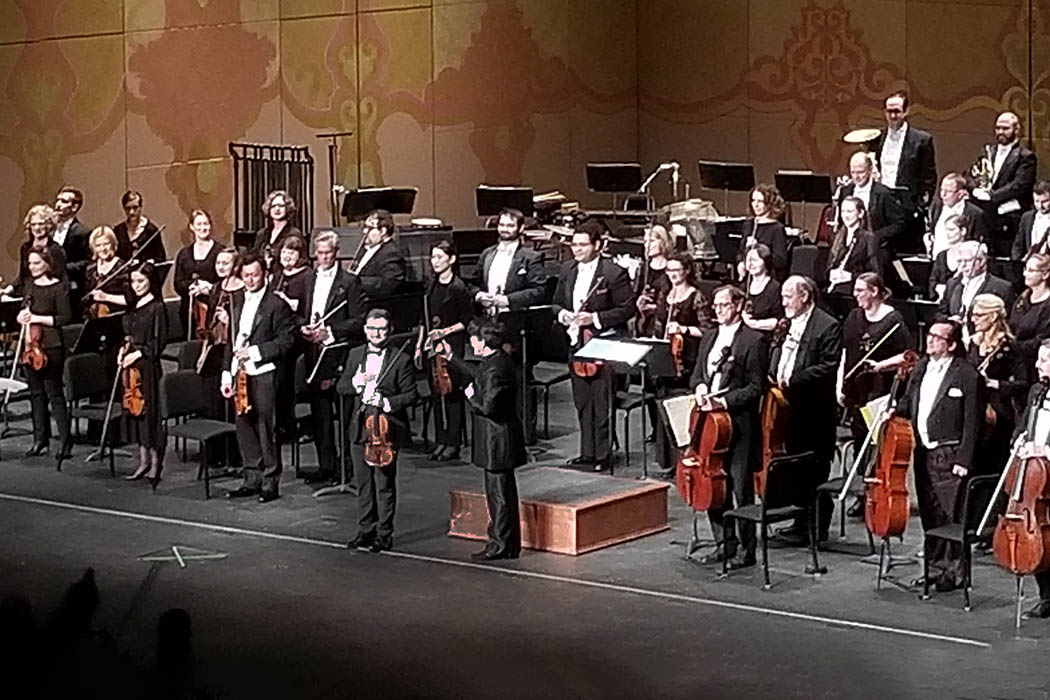It is something of an understatement that Felix Mendelssohn’s Violin Concerto in E minor is a vehicle for violinist stardom—either for those who already have acclaim and reputation, or for those who seem destined for acclaim and can electrify an audience. Prior to last weekend’s Knoxville Symphony Orchestra Masterworks concerts, the Mendelssohn concerto had last been performed by the KSO eight years ago with the violinist Midori as the name headliner. On last weekend’s concerts, however, the KSO chose wisely and turned to its own concertmaster, William Shaub, for the Mendelssohn. As the orchestra’s audience has come to recognize in his two seasons with the KSO, Shaub is a violinist who not only possesses the virtuosity required for the piece, but who also brings an energetic musical expressiveness that sings with a vibrant string tone and beautifully articulated passagework in every opportunity that comes his way.
With a wide variety of possible interpretations—straight or radical, clean or schmaltzy—Shaub chose an adventurous route through the Mendelssohn that was the essence of clarity, warmth, and eloquence, albeit with a luscious nod to early Romantic period passion. Although Mendelssohn’s orchestra is more accompaniment than featured performer in this concerto, Shaub was mindful of those conversational moments when themes are taken, presented, and echoed. I’ll admit to thanking Zeus for those moments and for the applause-less transition between the first and second movements that is accomplished with a satisfyingly theatrical sustained B from a solitary bassoon.
As if the Mendelssohn concerto needed more energy last weekend, guest conductor Mei-Ann Chen was on hand to lead that orchestral accompaniment to Shaub’s engaging take. Chen literally radiates energy from the time she walks on stage, that energy becoming precision and passion from the first downbeat. And, importantly, she clearly has a finely tuned sense of what requires prominence and what requires collaboration.
In the prominence department, Chen opened the concert with Aaron Jay Kernis’ Too Hot Toccata, a work of cacophonous delights from 1996 that must be as fun to perform as it is to hear. Composed for the St. Paul Chamber Orchestra, the work was obviously designed to showcase that orchestra’s sections and players, and ultimately, those of any orchestra that programs it. Its wealth of percussion effects kept the KSO percussion performers engaged, as did the “hyperactive” exposed parts for piano (Emi Kagawa), clarinet (Gary Sperl), and trumpet (Phillip Chase Hawkins).
As one of America’s most exciting contemporary composers, let’s hope that Kernis stays prominent on the KSO programming calendar in the future. Kernis won the 1998 Pulitzer Prize for Music for his String Quartet No. 2; just last month, he won the 2019 Grammy Award for “Best Contemporary Classical Composition” for his Violin Concerto.
In an evening that wandered quite deliberately all over the musical map, two contrasting works with ballet origins in their DNA made up the second half of the program: William Walton’s Suite from The Wise Virgins and Paul Hindemith’s Symphonic Metamorphosis on Themes of Carl Maria von Weber.
The William Walton suite began life as a 1940 ballet by Frederick Ashton for what would later become the Royal Ballet, with music from J.S. Bach’s cantatas and chorale preludes arranged and orchestrated by Walton. While the ballet score has been lost, Walton’s suite of six sections remains, melodically true to Bach, although departing substantially in orchestral colors and textures.
Also from the 1940s, Hindemith’s Symphonic Metamorphosis on Themes of Carl Maria von Weber had, thankfully, a different direction in mind. Begun as ballet music for choreographer and dancer Léonide Massine, the project fell apart for the usual “artistic differences,” leading Hindemith to complete the four movement work for a 1944 premiere by the New York Philharmonic-Symphony Orchestra under Artur Rodziński.
Using various pieces from incidental music that Weber composed for a play based on the Turandot story, Hindemith brightened the colors and expanded the sonic appeal, adding substantial depth and interest. Chen submerged herself in those textures and in that depth—sans score—muscling the sections of orchestral sound about as paint on a palette. The second movement, the Turandot Scherzo, was electric and mindboggling, pulling jazz colors from the KSO brass and winds. Chen brought the Andantino third movement down to lyrical earth and to a degree of strange gentleness, saving up power and sonic strength for the deliciously eccentric, exuberant, and rambunctious finale March that was executed with perfection.
With the orchestra having given its breathless all in the Hindemith, Chen made sure that every section of the orchestra got the applause they deserved, coaxing the audience into a prolonged display of appreciation. To be honest, though, no one I saw needed to be coaxed to jump to their feet to reward the orchestra for an evening of solid performances.








